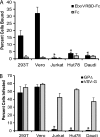Cell adhesion promotes Ebola virus envelope glycoprotein-mediated binding and infection
- PMID: 18448524
- PMCID: PMC2446962
- DOI: 10.1128/JVI.00425-08
Cell adhesion promotes Ebola virus envelope glycoprotein-mediated binding and infection
Abstract
Ebola virus infects a wide variety of adherent cell types, while nonadherent cells are found to be refractory. To explore this correlation, we compared the ability of pairs of related adherent and nonadherent cells to bind a recombinant Ebola virus receptor binding domain (EboV RBD) and to be infected with Ebola virus glycoprotein (GP)-pseudotyped particles. Both human 293F and THP-1 cells can be propagated as adherent or nonadherent cultures, and in both cases adherent cells were found to be significantly more susceptible to both EboV RBD binding and GP-pseudotyped virus infection than their nonadherent counterparts. Furthermore, with 293F cells the acquisition of EboV RBD binding paralleled cell spreading and did not require new mRNA or protein synthesis.
Figures




Similar articles
-
Cell-cell contact promotes Ebola virus GP-mediated infection.Virology. 2016 Jan 15;488:202-15. doi: 10.1016/j.virol.2015.11.019. Epub 2015 Dec 3. Virology. 2016. PMID: 26655238 Free PMC article.
-
Enhancement of Ebola Virus Infection via Ficolin-1 Interaction with the Mucin Domain of GP Glycoprotein.J Virol. 2016 May 12;90(11):5256-5269. doi: 10.1128/JVI.00232-16. Print 2016 Jun 1. J Virol. 2016. PMID: 26984723 Free PMC article.
-
Ebola virus uses clathrin-mediated endocytosis as an entry pathway.Virology. 2010 May 25;401(1):18-28. doi: 10.1016/j.virol.2010.02.015. Epub 2010 Mar 3. Virology. 2010. PMID: 20202662 Free PMC article.
-
Growth-Adaptive Mutations in the Ebola Virus Makona Glycoprotein Alter Different Steps in the Virus Entry Pathway.J Virol. 2018 Sep 12;92(19):e00820-18. doi: 10.1128/JVI.00820-18. Print 2018 Oct 1. J Virol. 2018. PMID: 30021890 Free PMC article.
-
[Research progress on ebola virus glycoprotein].Bing Du Xue Bao. 2013 Mar;29(2):233-7. Bing Du Xue Bao. 2013. PMID: 23757858 Review. Chinese.
Cited by
-
Antibody-Dependent Enhancement of Ebola Virus Infection by Human Antibodies Isolated from Survivors.Cell Rep. 2018 Aug 14;24(7):1802-1815.e5. doi: 10.1016/j.celrep.2018.07.035. Cell Rep. 2018. PMID: 30110637 Free PMC article.
-
The Myeloid LSECtin Is a DAP12-Coupled Receptor That Is Crucial for Inflammatory Response Induced by Ebola Virus Glycoprotein.PLoS Pathog. 2016 Mar 4;12(3):e1005487. doi: 10.1371/journal.ppat.1005487. eCollection 2016 Mar. PLoS Pathog. 2016. PMID: 26943817 Free PMC article.
-
Filovirus Strategies to Escape Antiviral Responses.Curr Top Microbiol Immunol. 2017;411:293-322. doi: 10.1007/82_2017_13. Curr Top Microbiol Immunol. 2017. PMID: 28685291 Free PMC article. Review.
-
Structure of the Ebola virus envelope protein MPER/TM domain and its interaction with the fusion loop explains their fusion activity.Proc Natl Acad Sci U S A. 2017 Sep 19;114(38):E7987-E7996. doi: 10.1073/pnas.1708052114. Epub 2017 Sep 5. Proc Natl Acad Sci U S A. 2017. PMID: 28874543 Free PMC article.
-
Ebola virus exploits a monocyte differentiation program to promote its entry.J Virol. 2013 Apr;87(7):3801-14. doi: 10.1128/JVI.02695-12. Epub 2013 Jan 23. J Virol. 2013. PMID: 23345511 Free PMC article.
References
-
- Chesnokov, V. N., and N. P. Mertvetsov. 1990. The effect of translation inhibitor cycloheximide on expression of mammalian genes. Biokhimiia 551276-1278. - PubMed
-
- Graham, F. L., J. Smiley, W. C. Russell, and R. Nairn. 1977. Characteristics of a human cell line transformed by DNA from human adenovirus type 5. J. Gen. Virol. 3659-74. - PubMed
Publication types
MeSH terms
Substances
Grants and funding
LinkOut - more resources
Full Text Sources
Medical

